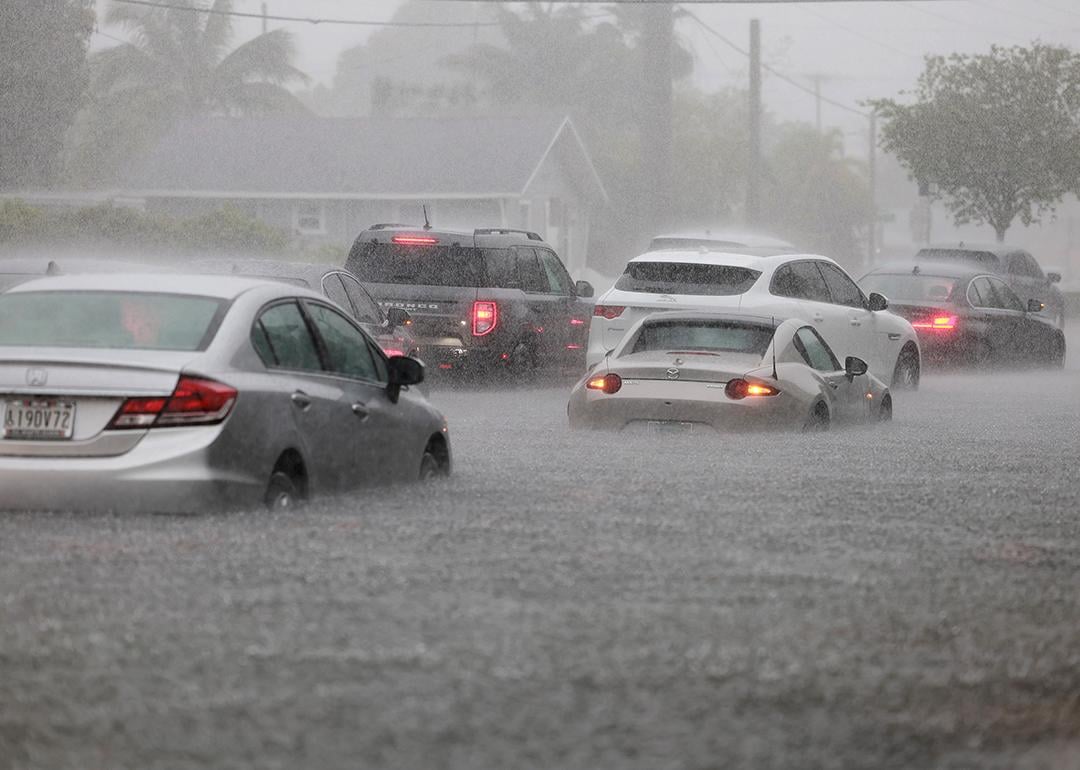
This story was produced by Edmunds and reviewed and distributed by Stacker.
How to avoid buying a flood-damaged car
Buying a cheap, flood-damaged car might seem appealing since it might not have any visual damage, but the host of issues it could be hiding might cause serious problems. There are also shady sellers who might try to pass off a flood-damaged car as a perfectly good vehicle. Edmunds shares how to avoid buying a flood-damaged car, as well as some telltale signs to look for.
What Happens to a Car in a Flood?
It may seem obvious, but when a car spends time underwater, a number of really bad things happen. First, the carpets and seats absorb water, which can be very difficult to fully displace. If the car isn't fully dried out properly, it can lead to mold growth, and some mold, like black mold, is extremely dangerous. In addition to absorbing water, there are plenty of small nooks and crannies for water to collect and pool in, and again, if these aren't properly dried, the issue will lead to increased humidity in the vehicle and more mold growth.
The odds are good that if a car is caught in a flood, the driver wouldn't have had time to disconnect its battery beforehand, which means that water can get into the many electrical connections and modules inside the car and cause short circuits. This can lead to a seemingly never-ending parade of electrical gremlins that are time-consuming and expensive to track down. If a car is flooded with saltwater, it's even worse since that will likely cause widespread corrosion throughout its wiring loom and control modules.
Other issues, like water getting inside the engine or fuel system, are serious but more easily rectified in all but the most extreme cases, provided someone doesn't try to start the flooded engine.
Title Washing
Most people understand that buying a vehicle with any kind of branded title—a title that notes serious damage—comes with risks. What if a flood-damaged vehicle is sold with an unbranded title? This happens not infrequently, and the process is known as "title washing."
Title washing is where someone takes a vehicle with a salvage title due to flood damage in one state and then sells it in another state with different rules or criteria for what counts as a "branded" vehicle. This works because of the sizable differences in vehicle registration laws from state to state, and it can be hard to tell when a car has had this done. Most commonly, a fraudulent seller will buy a flooded car from somewhere like Florida and then sell it in an area that doesn't experience these kinds of weather events, like Arizona, since buyers might be less likely to know what to watch out for.
How to Protect Yourself
The first thing is to get the vehicle identification number (VIN) and use a car history checker service like Carfax to verify that what the seller is saying is true. You can also use the VINCheck service from the National Insurance Crime Bureau to back up that Carfax, and it's free. The National Motor Vehicle Title Information System is also an excellent resource for shoppers who feel they may be at risk of buying a vehicle with a checkered past.
Next, get the car you're looking at inspected by an ASE-certified mechanic. If there's anything untoward about the car, the odds are good that a mechanic will find it. An inspection usually costs just a few hundred dollars, and if the seller won't consent to one, that's a major red flag and a good sign that you should walk away.
Lastly, significantly reduce your exposure to the risks of buying a title-washed vehicle by shopping with a reputable used car dealer like CarMax. Larger dealer networks like these build their brand on selling quality used vehicles that often come with a limited warranty, so if, for some reason, a bad apple slipped through the cracks, you would have recourse as a buyer.
More Signs That a Car Has Been in a Flood
In addition to checking the vehicle's history, keep an eye out for some telltale signs of a car having been underwater. These include:
- Fogged headlights or taillights
- Moist carpets
- Damp or mildewy smell
- Water line stains on door panels, etc.
- Moisture in the trunk, especially under the trunk floor
- Debris or detritus stuck in openings under the car or in vehicle components
- Electrical components that don't work
None of the above are definitive on their own, but if you find a few of those flaws, it might be a good excuse to walk away and find a different car.
Can It Be Worth Fixing a Flood-Damaged Car?
What do you do if you've already bought a flood-damaged car and the seller is long gone? Can a flood-damaged car be fixed?
In short, the answer to this question is both yes and no. Whether it's economically viable to fix a flood-damaged vehicle depends on many factors. First, determine just how bad the vehicle is. If it's damp all the time and smelly, but everything works, then a thorough clean where the interior comes fully out of the car and is dried completely might be enough.
If there are multiple intermittent electrical issues, issues where features don't work at all, or perhaps fuses keep blowing during routing operation, then it's likely that there is serious electrical damage stemming from water intrusion. If it's one or two modules or a few crusty connectors, then this is usually repairable, but if the car was flooded with saltwater and the wiring harness has turned green and started to crumble, then it's probably best to cut your losses.



